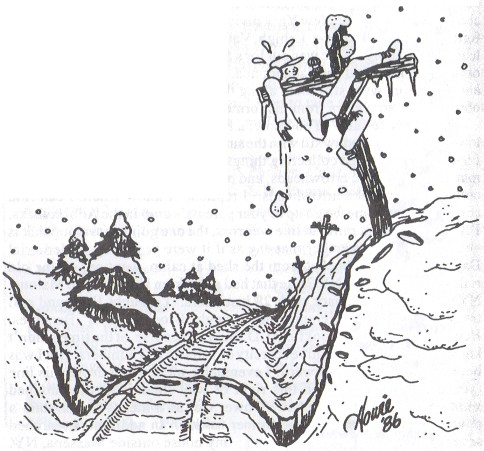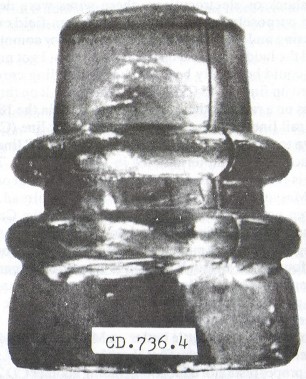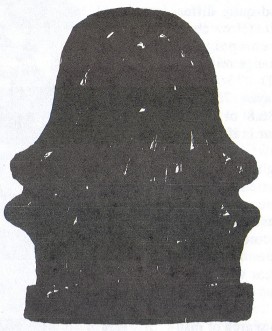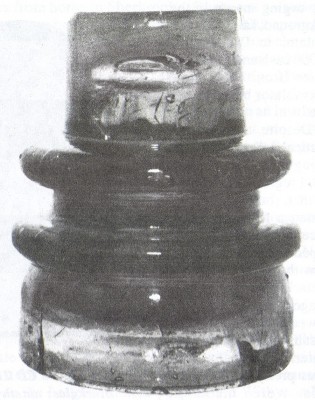An Insulator Search - One Man's Quest
by Kerry Lavendoski
Reprinted from "Crown Jewels of the Wire", March 1994, page 11
"I've had a great time the past 25 years searching for insulators."
In the beginning there were no insulators -- oh they were there all right! --
but I really didn't notice them. I recall at age 6 or 7 visiting my
grandmother's small farm in rural Bucks County, Pennsylvania and being always
intrigued by the singing wires on the poles next to the dirt road out front of
the house. There were those lines of wires with glass knobs with that humming
noise! The music those wires made fascinated me more than the
"insulators." It wouldn't be until about 20 years later that the glass
knobs would finally catch my collecting attention.
By that time I was living in
northern New York on the Canadian border having moved there from Pennsylvania
after graduation from high school. I was working for a Philadelphia based super
market. One day my wife was reading an article to me from our company magazine
about the hobby of the New York division's personnel manager. He had formerly
worked. for the Lehigh Valley Railroad and one day, after leaving their employ,
he was out for a Sunday drive and noticed that one of their rail lines had been
abandoned. However, he noted that the poles and insulators were still there
along the right of way, so he decided to obtain a few souvenirs from his former
employer.
My wife said: "You know, a few of those old insulators would look
nice on our window sill with the sun shining through. "Well, as a boy I had
always enjoyed collecting things, having collected stamps, coins, match book
covers, arrowheads, and marbles and at that time I was still collecting coins
and arrowheads. I replied: "I know where I can find some! The next time we
go up to your parents' camp in the Adirondacks, I'll look along that railroad
line we cross, the one going into camp that is abandoned." I remember that
day as if it were yesterday -- Memorial Day, 1969. 1 got a bucket from the shed
at camp, went out on the old railroad bed (it was a NYC line that had gone from
Utica, NY to Malone, NY) and later came back with 28 insulators. I thought I'd
found real treasure. Only 3 different kinds though, Brookfield 'B' Beehives,
Hemingray 42' s and Brookfield CD 152' s. Of course, at the time I didn't know
anything about relative scarcity or value or CD numbers. But I was hooked from
that day forward! I eventually walked and drove this line (you could drive a car
on this right of way since it was maintained somewhat by Niagara Mohawk Power
Co. as a means to maintain a power line that paralleled the former tracks). In
addition, I searched several abandoned railroads closer to my house outside
Massena, NY.
I walked sections of the old Rutland railroad which went from Rutland, VT to
Ogdensburg, NY and eventually discovered a couple of people, one in Madrid, NY
and one in Winthrop, NY who also had searched this line and who had begun a
collection of insulators. By this time a couple of years had gone by and I had
what I thought was a reasonably good collection of insulators from what I'd
found and what I had traded for with these two other collectors. At this point
my collection was on the verge of a "real explosion" and my wife
wished she'd never read that article to me. I say this because there was one
line near Massena that had abandoned poles along it but the tracks were still
being used. Up to this time I had only looked along totally abandoned railroads.
But one day I got up the courage to walk along a secluded section of this line
and shimmied up a couple of poles to add items to my collection -- a few shapes I
didn't have (they turned out to be Brookfield and Hemingray signals). Climbing
two poles in this manner just about did me in! So to get others I wanted, I took
a long branch from a downed tree and tried to twist the next insulator off its
pin. I ended up breaking it (it was a Dwight Pattern). Even though this line was
in the U.S. there were many Canadian origin insulators on these lines
along the border. I decided to try this method once more. The next one
"popped" right off and because it was still attached to the wires it
ended up about head high right before me, allowing me to disconnect it from the
line. It was threadless! I realized the next time back I had to bring a ladder --
I didn't have to worry about electrical shock or electrocution -- these wires were dead because they had been
purposely cut by a crew at each farm-field crossing and each road crossing and
were eventually scheduled for complete take down.

I only used the ladder method
once, and after that I got myself a set of climbers so I could hopefully beat
out the dismantling crew. As it turned out, I ended up finding 15 CD 728' s on
this line all on threaded pins on upright poles on a rail line that had first
been built in the 1880' s. The purpose of this rail line was to connect a Grand
Trunk line (Canadian) which came down to the border from Montreal with a NYC
line which came up from Syracuse, NY and terminated in Massena, NY. Today this
part of the line is run by CN from Montreal to Massena but originally it was
called the Massena Springs and Fort Covington Railroad.
As more time passed I
even got up the courage to venture into the Canadian section. (The personality
of the insulators changed in Canada -- no more threadless on upright poles -- but
much more colorful items!) I began to research what I'd found and through the
OBX magazine began to trade with a few distant collectors. My first trade of the
728 threadless was for an aqua and a clear Mickey Mouse. Boy, as I look back --
was that a lopsided trade! -- but then again -- I'd never seen a Mickey Mouse
insulator! My second trade was a little better -- a Mulford & Biddle UPRR for
my 728. I eventually went to my first show in Remson, NY and finally got started
on a proper insulator education, trading another CD 728 for an unembossed 731.
Now actually for the first time I knew about CD numbers.
As I walked more of
that Canadian section of the line, my trading stock really increased and my
collection grew by leaps and bounds. The explosion I mentioned earlier was
happening. l began to find nice blue CD 143 Montreal Telegraphs (no greens), GNWs
and fully written out Great Northwestern Telegraph Cos. I traded one of the
latter ones (it was unlisted at the time) to Marion Milholland for $100 worth of
insulators and an autographed copy of his book. I also found lots of CD 145 GNW
Tel Co. beehives in aqua and purple and three SCA Dwights as well as a few
Canadian Bostons. It took me about two years of walking and "picking"
to do the 70 miles of this Canadian section usually on Saturday or Sunday
afternoons. Finally up at the edge of Montreal one day, when I was doing a
section on Wednesday -- I met the dismantling crew -- their method: a chain saw to
the pole! Happily, as it turned out, I had been able to check all they had
abandoned years before, except the last mile where they had already cut the
poles down. It was now a lot easier to get at the "glass" but sadly --
now -- most of it was broken.
It was during this period when I would go over to
Canada weekly and do a few miles of that line, that I lost my job with the
supermarket and found myself unemployed. It was Memorial Day 1972, exactly three
years to the day that I had first hunted insulators. Again we were going to camp. We always went to camp on Memorial Day but this time I mentioned to
my wife that while there, I wanted to go over and visit a lineman I'd heard
about who worked for New York State Electric & Gas. He lived over by Lake
Champlain and I wanted to look him up and hopefully trade insulators with him.
Remember, at that time I was unemployed, had never paid money for an insulator
and had $29.00 to our name. So leaving my wile at her parents' camp near Owls Head,
NY, off I headed. After finding this lineman and trading a few insulators with
him, he said to me, "Did you ever see a clear glass threadless?" Not
being much of an expert on insulators at the time, I replied, "It must be a
reproduction." I asked, "Who has this insulator?" He replied,
"The little old lady next door." Well, obviously I just had to check
this out! The lady was home. I was shown the insulator and I was convinced it
was genuine and I asked her if she would sell it and for how much. That was a
brave question for me considering I only owned $29.00. She said: "I've
already been offered $100.00 for it!" It seems that in those days $100.00 was the ultimate insulator price for anything that was possibly rare and
unusual. After all we collectors didn't know what would end up being truly rare
or scarce or unusual in those days. I showed her my total bank roll and my
trading stock of purple insulators (she'd never seen purple insulators) and so I
was able to acquire that day the CD 736.4 that is pictured on page 332 of
Milhollands' book (1975 Third Revision) with my name and former New York State address beneath the photo. By the way, I gave her $25.00 and
three purple insulators for it. (I suspect it to be a product of the Sandwich
Glass Co.) Needless to say, as jubilant as I was with my trading and purchase of
the day, when I arrived back at camp, my wife did not share my enthusiasm!

C. D. 736.4
THREADLESS HAT-By Kerry Lavendoski, Brasher Falls,
New York
NO
EMBOSSING-Smooth Base-Clear
CD 736.4 as seen on p. 332 of
Milholland's Third Revision
I
think it was about a year and some months later when I was at a show in Scotia
NY, I ended up selling this insulator. I had built myself a small display case
to house my small collection of threadless which by this time was about 5 pieces
(one of my 728' s, the 735 Mulford and Biddle, the 731 No Name and a 742 MTC in
addition to the 736.4). This woman came up to my display case, which was sitting
on my sales table, and she asked: "Is this insulator for sale?"
(Meaning the 736.4.) I said, "No, these are my threadless collection."
All the while my wife sitting behind the table is saying, like a cheerleader,
"Sell it! Sell it! Sell it!" The lady then said, "If it were for
sale, what would you ask for it?" (Recall as far as I was concerned in
those days the ultimate cash price for an insulator was $100.00.) So I replied,
"$500.00." She asked, "Would you take $500.00?" I asked
back, "Do you have $500.00?" She said: "Yes." All the while
my wife chanting, "Sell it! Sell it! Sell it!" I said, "OK."
And the woman reached in her pocket and from a large wad of $100.00 bills peeled
off five of them and the insulator was hers. I learned shortly after this that
her name was Dielene Coleman and that she had inherited a rather large sum of
money and she was buying what she considered to be one-of-a-kind insulators.
At
the time, my wife, young son and daughter and I were living in a partially
finished house I had begun building about six years before and that one
insulator bought seven windows and all the paneling for the living room and
dining room end of the house. I had the openings framed for the windows but
could never afford to finish putting them in so I had boarded up the openings
and insulated those spaces until I could afford the windows.
This was not going
to be the last time this lady spent money on my insulators, however. That same
summer I had lost my job with the supermarket, I decided to go into the
carpentry business on my own. Recall, I had undertaken trying to build by own
house, so I had a little experience. After doing a few jobs and having a little
bit of extra money (a couple of hundred dollars) I said to my wife Carolyn,
"Let's take a trip to New Brunswick. We could 'antique' and camp along the
way and I hear New Brunswick is a good place to find insulators." I figured
if I could offer her the opportunity to do a little antiquing (it was her
intention to furnish our ongoing new house with second hand-junk shoppe-antique
shop furniture), I might be able to also get in some good insulator hunting and
trading with collectors I'd heard about in New Brunswick. Well, we were barely 100 miles from home in Sherbrooke, Quebec at an antique shop (it
was actually a junque barn) and this guy had about 20 deep purple Canadian
Pacific 143s, and maybe 20 more Withycombes and about 20 GNW Tels in royal
purple. This batch of insulators plus some others he had was going to cost me
the $200.00 we'd saved for our trip. My wife was now nearly convinced I was
going crazy. Earlier in the year, for the first time ever, I had spent $25.00 of
the $29.00 we owned on an insulator and now "he wants to spend
$200.00!" on some more. Well, I, too, hated to spend all of our cash in one
place on insulators! Recall up to this point I always found these things for
free (well sort of, if you don't count gas and time and energy), So I said,
"Maybe I can go down to a Canadian Bank and borrow the money on my
MasterCard I just recently got for emergencies. After all, I think this is an
emergency." As it turned out, MasterCard was Chargex in Canada, so a new
era of financial experiences began for me. I later set up at the Middletown and
Scotia (New York) shows with those insulators and other duplicates I had and
more than got my money back. By the way, my wife also got some furniture on that
trip but we never got out of Quebec. In fact, we never did get to New Brunswick.
It was in that same Junque Barn, after finalizing my purchase of all the purples
and Withycombes, that this guy told me, "I had a red threadless a little
while back." I asked, "What happened to it?" He replied, "I
traded it for a hog scraper. I had a dollar on it because it was a little
chipped on the bottom." These purples and Withycombes were costing me about
$3.00 apiece whereas he'd had $1.00 on a "red threadless" because of a
few chips. (They certainly were the good old days!)
He told me who owned the insulator and gave me directions to his place. Sure
enough it was a "red threadless!" Oh, not pure red but red enough to
qualify for that description. It was a CD 726 cranberry red threadless, the
first one known to the hobby. Although at that time the collecting hobby in
general didn't know about it, only myself and another collector from Maine who
had stumbled into that junque barn before me by several months and had also been
given directions to the red threadless. Here was that number again, the Maine
collector had offered this man $100.00 for the insulator which this man had
turned down. After asking a few questions I found out this fortunate owner was
going to retire from the Canadian Postal Service in about a year and was
thinking of going into the antique business at that time. I said, "When you
do that, please write me, name your price, and I will buy the insulator."
About a year later I received a letter from this man. He had retired and the
insulator could be mine for $350.00. Needless to say, I bought it later that
week after finishing up a roof job so I would not have to use my MasterCard this
time. At the Hershey National in 1974, again with my wife urging me on in the background, I also sold this insulator to Dielene
for $1,000 cash and a CD 740 Foster Bros. This time the insulator built my
garage.
Despite the obvious practical dollar benefits of selling those two
threadless, I regretted having to do that, but my family needed a finished house
more. Also a garage helped to protect the car from the frigid northern NY
winters. Having a garage was the difference between starting the car most
mornings during the winter. Also by that time I was pretty sure the red 726s
were made at Hudson, Quebec and that more would turn up, which they have.

CD 718
Blackglass amethyst with collar
After
a few years, Dielene Coleman tired of her "one-of-a-kind" collection
and I heard she was selling out. By the time I contacted her, she had already
sold the CD 726 "red" to Fred Griffin (now deceased) but she still had
the clear hat. I repurchased it from her for $700.00 and so even though the
address is incorrect under the insulator on page 332 of Milhollands' 3rd
Revision, the owners name is correct. Also, I was aware of another threadless
she had that apparently most collectors did not know she owned. It had been dug
by a taxi driver in Smith Falls, Ontario and had found its way to her via a
collector/dealer in Napanee, Ontario. This insulator was also reddish, actually
it's best described as black glass amethyst. It does not pass light well except
through a large bubble in the skirt and at that place shows it to be reddish
purple. It is a CD 718 but taller than most with a collar-like-raised-band
encircling the skirt base. As far as I know, these two, the clear one and the
black glass amethyst, are unique at this time -- truly one of a kind. Please
compare the picture of the CD 736.4 clear one I own in Milhollands' book with
the CD 736.4 pictured in McDougald's book on page 291 (which I think is a photo
of the sapphire blue one) and you'll note that mine is squattier and quite different. (How about a campaign to change mine
to a CD 736.2 or maybe 736.6 or 736.8 or 736.9; that is if the yellow green and
light green are the same shape as the one pictured.) Just for the record, my
clear one is smoky clear with lots of tiny bubbles.
My quest in search of
insulators has left me with many fond memories. As I look back through a quarter
century of collecting, I realize that I've done very well at uncovering the
early threadless classics. I have done especially well with antique dealers, at
least the few that take a little bit of interest in insulators. For example,
shortly after the Hershey National, I received a call from an antique dealer in
Quebec with whom I'd left my name, address, and telephone number several years
before as well as my desire for old insulators. He said, "I have four
threadless, all with writing on the bottom, three that say DUPONT and one that
says M.T.Co." I arranged to buy them for that "magic number" of
$100.00 each. Actually when I arrived in person I was able to acquire them all
for $350.00. Another time there was an antique shoppe owner in northern NY who
had no insulators in her shop but said she had four old ones in her house. She
apparently knew that the threadless ones were something special and she
proceeded to show me a CD 743, CD 728, and two CD 740s, all unembossed. I wasn't
able to extricate those from her for about two years. Eventually I took my entire threadless collection to show her one day
(by that time it numbered about 15 pieces) and I guess the psychology worked
because then she realized what she had was not that great after all.

NO NAME
[No Embossing] SB
Dark Sapphire Blue, Yellow Green, Light Green, Clear
CD 736.4 as seen on p. 291 of McDougald's book
When I had
first met her I needed all her insulators except the CD 728 for my collection,
but by the time she finally sold them to me (again for about $100.00 apiece) I
only really needed and wanted the CD 730 which I still have. In more recent
years a visit to her shop has yielded a nice CD 732. Another Junque Shop owner
always seemed to turn up several good insulators each year. My best discoveries
from him were one group that included three Chicago Diamonds and a mint CD 739.
Another time he called and said, "I have one of those common threadless for
you and a 'hat' type." By then he knew the CD 728 was relatively common.
The "hat" turned out to be a CD 740.4.
Once my wife was picking up
furniture from an antique dealer she often dealt with and he said, "Doesn't
your husband collect insulators? I had a threadless one in my shop the other day
that came in with a box of things I got at an auction. It had several letters
written on the bottom. But there is this fellow that occasionally comes in here
and buys all kinds of things that he is storing in a large barn. He hopes to
sell all he has put aside some day in the future at a profit. I don't even know
his name, but next time he's in I'll find out who he is and where his barn
is." A couple months went by before I could track down this man and visit
his barn. I expected the insulator to be a CD 742 MTCo. It turned out to be a CD
732.2 LGT & Co. He had paid my wife's furniture dealer $5.00 for it. I was
about to buy it for $25.00.
I've had a great time the past 25 years searching
for insulators. My quest has taken me to parts of the country I might not have
otherwise visited, and to making acquaintances who share the enthusiasm for the
beauty and history of insulators.
In the beginning there may have been no
insulators, but in my case, the old adage has surely come true: "Seek and
you shall find."
|
